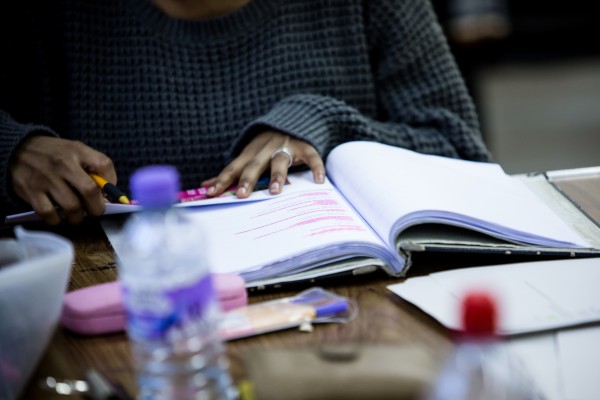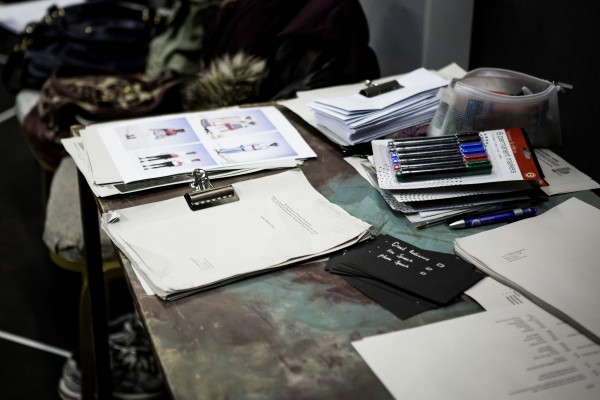The Student Guide to Playwriting | Rewriting
Thu 11 Feb 2016 |
Playwriting
The Student Guide to Writing: Playwriting is the first in a new series of competitions designed to share the best creative writing training with students and teachers at schools, colleges, Universities and elsewhere across the UK. You can find out more about the scheme here.
LESSON PLAN: REWRITING
BY CAROLINE JESTER, DRAMATURG AND AUTHOR OF PLAYWRITING ACROSS THE CURRICULUM
Congratulations, you’ve written your play. So why is there another lesson plan? Isn’t it time to hand the play over to a director, get the actors booked and stage the play?
This lesson plan will explore rewriting, which is the stage where a writer often begins to unearth the secrets that are in the script that they didn’t even realise were there. The aim of this lesson plan is to provide the writer with new ideas for their play, to facilitate the rewriting process.
We will explore how the collaborative nature of theatre can also be applied to the process of rewriting. We will take the first draft of the play and work together to establish what works well and what needs more research and/or rewriting. We will see if the writer’s intentions for the play are coming through in the text by examining scenes within the play. We will see if the characters’ objectives are clear and if the obstacles that are placed in front of them serve to push the action forward. We’ll see if the timeframe and structure supports the narrative and if the locations the characters inhabit support the dramatic action. And we’ll see if what the writer thought the play was about is translating from page to stage.

Each writer will finish with a list of questions and ideas that they can apply to their script. This will be achieved by inhabiting different ‘roles’ within the craft of dramatic writing; the playwright, the actor and the dramaturg. We shall explore a situation similar to the professional playwright’s ‘workshop phase’. A stage in new writing development where actors read through an early draft of the script with the purpose of developing the play, not judging the material as a finished piece.
WHY THIS AREA OF CRAFT IS IMPORTANT.
The play is written and the writer is confident that it will be easily translatable to the creative team; the actors, director, producer, designer and ultimately the audience.
There are many names for this first draft, and many unpopular with writers, but unless it is one of those rare gems that need little reworking this will be in a raw state. It can be disheartening if a writer hands their play over to others to read and they come back with a list of questions that the writer believed were clearly answered through the characters’ actions within their play.
Reflective practice is a crucial skill a writer needs to develop to be able to push their work to the next level by rewriting, rewriting and a bit more rewriting. To ensure their brilliant idea, the one that made them sit at the desk typing away for hours when they could have been partaking in other more social activities, does what they expected it to do. It’s all too easy to send that first draft off before reflecting on whether those scenes that you thought were brilliant writing, even though they feel out of character with the action of the play, are actually needed. Is that monologue half way through pushing the story forward or being used as a mouth piece for the writer’s ideas rather than their characters? Can the writer really introduce ten new characters in the penultimate scene because they feel this makes it easier for the protagonist to get that backstory in that wasn’t realized at the beginning of the play? Isn’t this functional rather than active, something no one will really notice, will they…
These are the things you want to iron out of your script before you send it off to producers. It takes skill to look at your play from this critical angle but once you develop this, it will only serve to support your play and future writing. Your characters will begin to take on a life of their own that is separate from your initial intention. The play will be alive, and it is this that will make your work stand out.
Rewriting is exploring the work in progress and open to many changes along the way. Don’t be afraid of this stage because the deeper you dig, the more discoveries you’ll make along the way, not only about the play you’re writing now, but about you as a writer.
A SIMPLE EXERCISE OR EXERCISES USING THIS CRAFT ELEMENT TO DEVELOP YOUR PLAY.

Group preparation
We will be working in groups. If you are working with a large class you might want to break this into smaller groups once you have established the principles. If you are writing on your own, now is the time to gather fellow students or a group of friends together. Each member of the group will change roles throughout the exercise and be the writer, actor and dramaturg. This will help the writers see plays from three different perspectives, fostering a more critical outlook on their own plays.
The writer casts the play from other members of the group, they become the actors. The rest of the group will act as ‘dramaturgs’. A dramaturg in this instance is someone who will ask questions about the play to help push the writer into thinking more deeply about their work, both the subject matter and its mechanics. What the dramaturgs are not there to do is to suggest ‘better’ ways of writing the play.
Once the play has been cast by the writer each ‘actor’ will be given a copy of the script. If the scripts are short and time permits read the whole play but if time is limited and it is a full length piece then this exercise can work by using a single scene or scenes from the play. The scenes do not have to be taken chronologically and it is a useful exercise to choose a scene or section that isn’t quite working rather than using this as an exercise to present a ‘polished’ section. The aim of the exercise is to enable the writer to find a route into reworking the play rather than staging the text.
It is useful to give a time limit on each scene or extract as this can help facilitate an understanding of what can be achieved in terms of action within a play in a certain time-frame.
So we’re ready to go. We’ve got the writer, the actors and the dramaturgs. And the first draft…
The writer can give a brief introduction to the characters to help the actors understand them but they are not allowed to give an introduction to the play. For example they can say things like:
Jack 28, an environment agency worker
Naylah, 40 a secondary school teacher
Tess, 14 and loves to row
What we don’t want is an introduction that tries to explain what the whole play is about and the relationships between characters, therefore ‘planting’ ideas for reactions from the ‘dramaturgs’. We’re aiming to see what is already in the play. We want to see what it shows us through the dramatic action.
One thing I liked about the scene
The actors now read the scene to everyone. Here’s an example of a précis of the action within a scene:
Naylah is refusing to evacuate her flat, which is flooded from the river near her home that has burst its banks. She won’t leave until someone comes with boxes to put her two cats in. Jack needs to get around all the other houses and doesn’t have time for this. Evacuate means evacuate. Tess appears on her own with a cat box. How did she get down the street on her own when all the boats are in use by the rescue teams? Where did she find this boat?
All the dramaturgs must say one thing they liked about the play or scene. There are no rules or restrictions to apply here and there can be repetition. For example:
I liked the way Tess appeared in a boat on her own
I liked the fact that Naylah wouldn’t leave the flat without her cats
The only rule is that all of the dramaturgs must say something. The writer will write these down but will not respond. Once all the dramaturgs have responded the writer will now have a list of things that people like about their play. This might connect with the writer’s intention or provide insight into things and characters an audience is intrigued by. The writer might be surprised if they thought the play was about one character’s story and everyone is more intrigued by another character. This can unlock new ideas and connections that hadn’t previously been explored.
A question
Now we’re going to dig deeper and see if we can help the writer understand what isn’t clear about the scene. The dramaturgs will now all:
Ask one question about the play/scene they have heard
Once again the writer cannot respond and must write the questions down. If the writer does start to answer the questions, because this is an instinctive response when questioned, remind the writer that they are being provided with questions to reflect on for the rewriting process. If they are explaining the play then it might also be due to lack of clarity in the script. An area to rewrite….
It did not matter if the dramaturgs repeated things they liked in the previous exercise because this served to indicate to the writer what an audience might respond well to. The questions about the play/scene, however, have a few rules. They cannot be subjective such as:
I didn’t like the way Jack was moaning, I’d have written the scene completely differently
It doesn’t make any sense that Tess appears from nowhere.
Naylah wouldn’t stay in her flat. It’s too unbelievable
What we are looking for here instead of opinions are questions that explore the scenes that have been read. If theatre is something that happens in the present then we are dealing with the specifics of any given moment to generate the action. We’re looking for questions about what is happening in the scene to provide the writer with a new set of keys to open doors within their play that were previously locked to them. By focusing on specific questions that relate to the scene we have heard we can begin to unearth things that might need exploring in the rewrites.
For example if it’s unclear why a character is doing something in a scene, if it doesn’t feel like they would be doing what they are doing then a way to explore this could be through questions such as:
Where has Tess just come from?
Has she got her parents’ permission to rescue people?
Is Tess trying to rescue other people or just Naylah?
By understanding where the characters have just come from immediately prior to the scene you begin to explore how and why they are behaving the way they do. If they’re agitated this could be because of a previous encounter that was stressful that is making their behavior in this scene unusual. We don’t want this information through exposition but through the subtext that is generated by the dramatic action, what they are doing in that moment. This can be developed into:
What is Jack’s objective in the scene?
Does Jack really want to help Naylah leave her flat?
Has Tess stolen the boat?
We start to see what’s happening in the scene and subsequently the characters’ journeys within the wider play. If we develop this into seeing what stops them getting what they want, their obstacles, we can see if there is conflict driving the scene forward.
Is Naylah preventing Jack from rescuing other residents?
Is Tess beneficial to Jack’s rescue mission or another problem because she’s now another person to evacuate?
Questions about the location and environment can help facilitate the writer’s understanding of how characters behave and is often something that isn’t thought about fully in a first draft. If we look at location as active, a character in itself then this can help the characters too. The questions are often very simple:
Does the scene happen outside the door to Naylah’s flat?
If we’re inside her flat then in which room? Be specific.
How deep is the water and how has this affected the environment within the flat?
Is she standing on tables holding her animals?
If the scene is in a public space then who else is there?
Has the writer explored structure and timeframe fully? Does this support the narrative they want to tell? The questions do not have to be complicated to ignite a writer’s understanding of choices they are making.
What time of day is it?
Will the play take place over 24 hours or 3 years?
Will the play take place in real time?
This helps to think about the emotional journeys of the characters and if the key events within the play are placed correctly to achieve the writer’s intention. If the play takes place over 3 years then it will more than likely not be a highly charged emotional drama or have an imminent sense of urgency.

An actor’s response
Now let’s turn to the actors. They will ask one question each but the rule here is that it has to be a question that is related to the character and/or the relationships between the characters they were reading. For example:
How long has Jack been working for the environment agency?
Is Naylah Tess’ teacher?
If Naylah is Tess’ teacher how well do they get on in class?
When did Tess become interested in rowing?
If an actor says something like:
I don’t think Tess would shout at her teacher
try to explore this further by turning it into a question with reference to the scene such as:
Has Tess ever shouted at her teacher Naylah before?
This simple question opens up the characters’ histories and the subtext as well as thinking how an actor would play this by understanding what is happening in this moment. The writer does not answer the questions but writers them down.
Three lists
The writer will now have three lists:
The first list will give the writer an idea of what an audience is connecting with through what they immediately liked about the play.
The second list will contain questions about the scene/play that the writer can answer after they have reflected on them.
The third list might be similar to the second list but it should contain more specific questions about characters and their relationships.
The process will be repeated for each play and the roles will be swopped until everyone has inhabited the skin of the writer, actor and dramaturg.
Sitting down to rewrite alone
The writer can become overwhelmed with all this feedback. This then is another crucial stage in learning to trust your own voice. If a question feels unhelpful then strike it from the list. You’ve been writing your play and know more about it than anyone else and if it feels out of sync with the play then do not become fixated on answering all the questions. If there is repetition, however, then pay attention to the question because there might be something crucial here that could push the narrative forward or provide inside into a missing link. Once you have reflected on the questions from the group try to look at each scene within your play and answer the following questions:
What does each character want at the beginning of the scene?
What stops each character achieving what they want in the scene?
Is the location of the scene being used effectively by the characters or should they be more aware of their environment?
What happens in the scene?
What has changed for each character by the end of the scene?
If we look at each scene as a small unit of action within the whole play then something must happen. If a scene does not work then it is often because the writer feels we need a scene that tells an audience something, is expositional, rather than allowing the characters to show us through dramatic action. The play is a constellation of characters in a slice of life chosen to explore something a writer feels needs telling. The writer chooses carefully by being specific about what is needed to achieve this.

So what’s the play about then?
Finally in one sentence write what the play is about.
Has this changed from when you started writing the play?
It may change again as you begin rewriting but it’s a useful sentence to put above your laptop and remind yourself what you’re trying to achieve and keep focused. The aim of rewriting is to turn the raw material from the first draft into a focused and specific piece of dramatic writing that would have answered some of the questions the dramaturgs thought were important in the first draft so it’s ready to be staged.
FINAL ADVICE
The aim of these exercises is not to follow the advice of another and rewrite your play to answer all the questions but to see what is already there in your work. To help develop reflective practice.
Playwriting is ultimately collaborative, because it is written for others to play and for an audience to be witness to. What we’re hoping to explore here is applying the collaborative process to the writing stage in the form of seeing how the work translates before the audience comes in so we can sharpen the text and narrative.
As writers, though, your role is to be discerning at all stages. If the feedback doesn’t feel right, then reflect on this but be ready to disregard it. This is part of the rewriting process, you understanding your material more and taking charge of it as it changes along the way. We want to see work that has a strong authorial voice on our stages and the process of rewriting is ultimately about you as the writer, asserting your voice through work that resonates with your audience.
You should now be ready to revise your play. Next week’s lesson plans will be on Staging Your Work by Caroline Horton, playwright and mentor from the Bush Theatre, and Final Advice from Lucy Kerbel, founder and Director of Tonic Theatre.
To read all of the previous lesson plans click here







